高中英语必修2 Unit 1 Cultural relics Reading 课件 (共16张PPT)
文档属性
| 名称 | 高中英语必修2 Unit 1 Cultural relics Reading 课件 (共16张PPT) |  | |
| 格式 | zip | ||
| 文件大小 | 14.9MB | ||
| 资源类型 | 教案 | ||
| 版本资源 | 人教版(新课程标准) | ||
| 科目 | 英语 | ||
| 更新时间 | 2016-07-12 10:14:08 | ||
图片预览

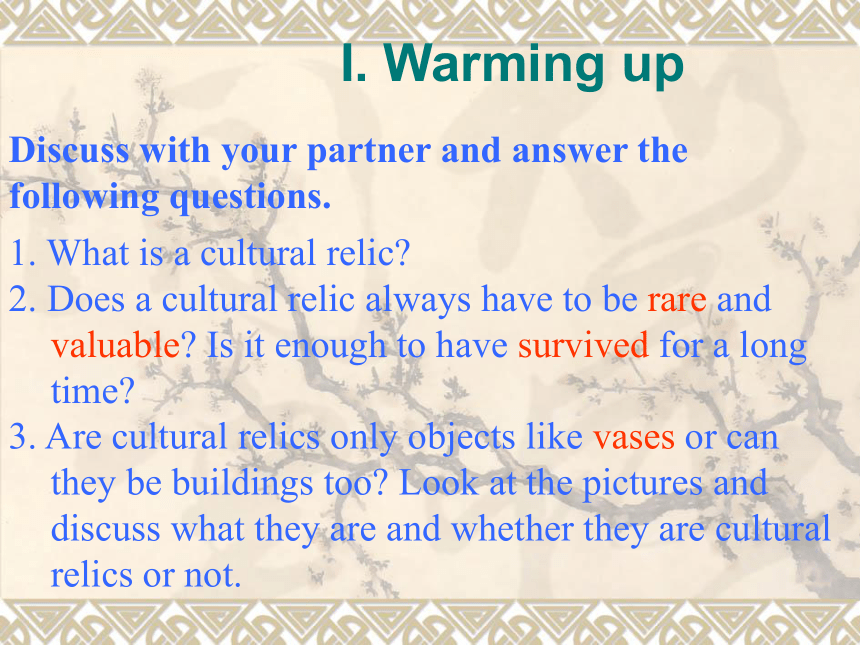
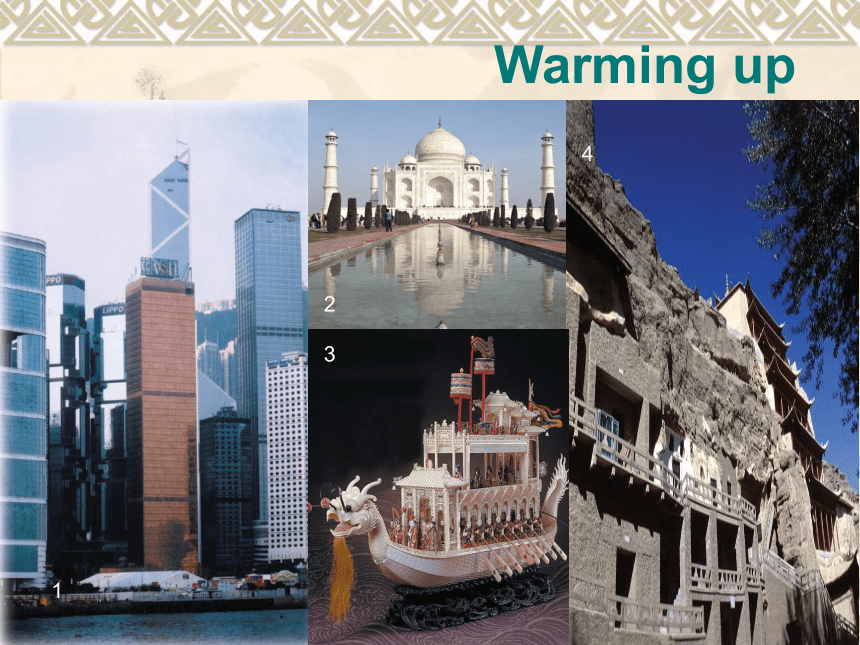
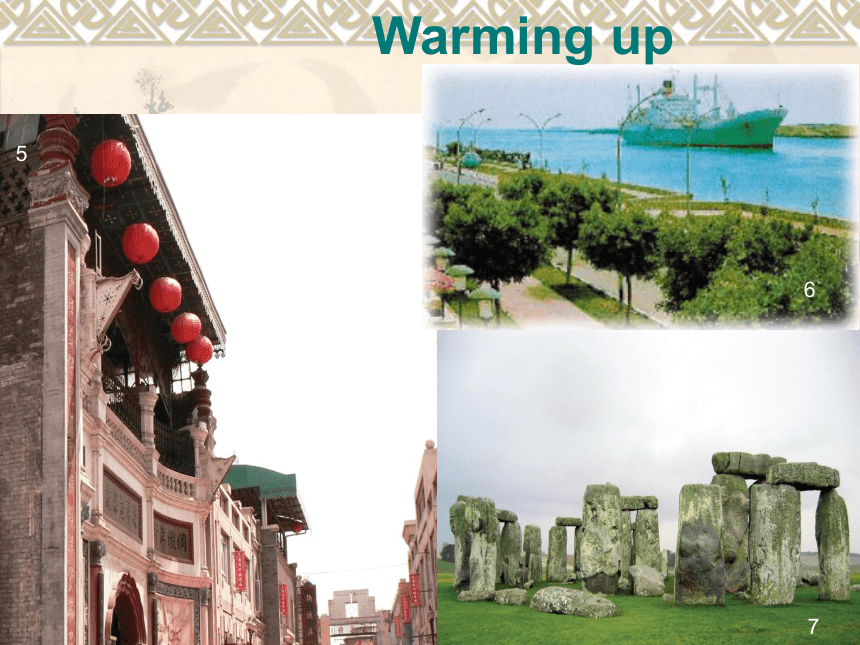
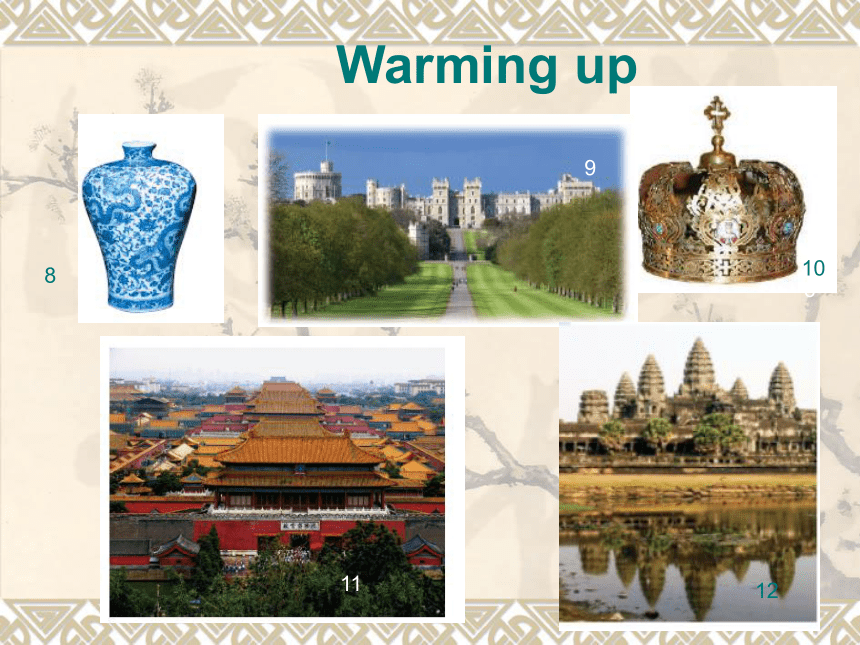

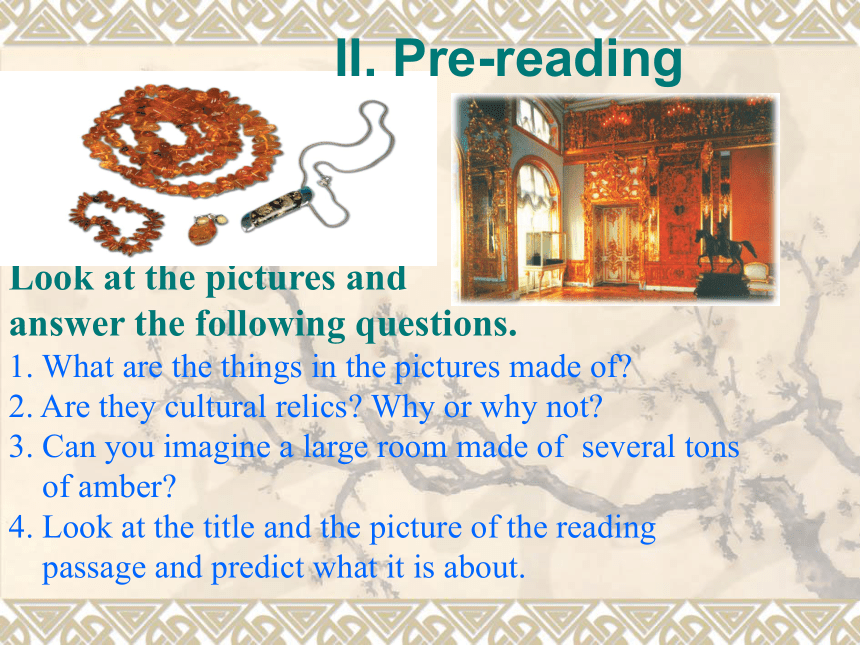
文档简介
课件16张PPT。
Unit 1 Cultural relics
Period 1 Reading
I. Warming up
1. What is a cultural relic?
2. Does a cultural relic always have to be rare and valuable? Is it enough to have survived for a long time?
3. Are cultural relics only objects like vases or can they be buildings too? Look at the pictures and discuss what they are and whether they are cultural relics or not.
Discuss with your partner and answer the following questions.
Warming up1234Warming up567Warming up8679101112
A cultural relic
is any object, building or item that was made sometime in the past. It may be many thousands of years old or it may be a few hundred;
may or may not be valuable;
tells us something of the way people lived at the time it was made. This may be because of its method of manufacture or how the item was used.Warming up
Look at the pictures and
answer the following questions.
1. What are the things in the pictures made of?
2. Are they cultural relics? Why or why not?
3. Can you imagine a large room made of several tons of amber?
4. Look at the title and the picture of the reading passage and predict what it is about.
II. Pre-reading
1. Find in the vocabulary list of this unit some
adjectives which can be used to describe cultural relics.
rare, valuable, amazing, fancy, wooden, former, worth
2. Find some nouns which refer to cultural
relics.
vase, jewel, painting, castle
3. Find some verbs which refer to building
or taking apart of cultural relics.
survive, select, design, decorate, remove,
take apart, explode Pre-readingIII. While-reading How did the Amber Room become one of the wonders
of the world? How was a new Amber Room built? How did the Amber Room get lost? How was the Amber Room made? Why did the King of Prussia give the Amber Room to the Czar
of Russia as a gift? 54132The following five questions summarize the main idea of the five paragraphs in the passage. Put the paragraph numbers in the box. Then answer the questions.While-readingKey1. It took the country’s best artists about ten years to make the Amber Room. Several tons of amber were used to make it, and it was also decorated with gold and jewels. The design of the room was in the fancy style popular in those days.
2. The King of Prussia wanted to have a troop of the Czar’s best soldiers.
3. Catherine II told her artists to add more details to the Amber Room. Almost six hundred candles lit the room, and its mirrors and pictures shone like gold.
4. In 1941, the Nazi stole the Amber Room.
5. A new Amber Room was built by studying old photos of the former Amber Room.
Read through the passage and fill in the form.
Frederick I1716Peter the Greathad the Amber Room moved outside
St PetersburgNazi2003While-readingbuildstolerebuiltRead paragraph 1 and 3 and tell why
the Amber Room is one of the
wonders of the world.
1. Several tons of amber were used to make it.
2. The design of the room was in the fancy style popular in those days.
3. It was also a treasure decorated with gold and jewels, which took the country’s best artists about ten years to make.
4. Almost six hundred candles lit the room, and its mirrors and pictures shone like gold.
While-reading
IV. Post-reading Work in pairs and retell the passage. The following form may help you.
Discuss the following question in groups of four.
Is it worth rebuilding lost cultural relics such as the Amber Room? Give your reasons.
Post-reading
Some useful expressions
Do/Don’t you think that …? Would you consider …?
Why/Why not? Do you have any ideas about …?
How do you know that? What do you think?
What do you think of …?
What’s your idea/opinion of …?
What are your reasons for saying that?
I think/don’t think that …
I agree./Sorry, I don’t agree. In my opinion, …
I don’t believe … because …
Post-reading
1. Listen to the tape and read the passage aloud, paying attention to pronunciation and intonation. Then sort out the sentences you do not understand.
2. Review the words you have learned.
V. Homework
Unit 1 Cultural relics
Period 1 Reading
I. Warming up
1. What is a cultural relic?
2. Does a cultural relic always have to be rare and valuable? Is it enough to have survived for a long time?
3. Are cultural relics only objects like vases or can they be buildings too? Look at the pictures and discuss what they are and whether they are cultural relics or not.
Discuss with your partner and answer the following questions.
Warming up1234Warming up567Warming up8679101112
A cultural relic
is any object, building or item that was made sometime in the past. It may be many thousands of years old or it may be a few hundred;
may or may not be valuable;
tells us something of the way people lived at the time it was made. This may be because of its method of manufacture or how the item was used.Warming up
Look at the pictures and
answer the following questions.
1. What are the things in the pictures made of?
2. Are they cultural relics? Why or why not?
3. Can you imagine a large room made of several tons of amber?
4. Look at the title and the picture of the reading passage and predict what it is about.
II. Pre-reading
1. Find in the vocabulary list of this unit some
adjectives which can be used to describe cultural relics.
rare, valuable, amazing, fancy, wooden, former, worth
2. Find some nouns which refer to cultural
relics.
vase, jewel, painting, castle
3. Find some verbs which refer to building
or taking apart of cultural relics.
survive, select, design, decorate, remove,
take apart, explode Pre-readingIII. While-reading How did the Amber Room become one of the wonders
of the world? How was a new Amber Room built? How did the Amber Room get lost? How was the Amber Room made? Why did the King of Prussia give the Amber Room to the Czar
of Russia as a gift? 54132The following five questions summarize the main idea of the five paragraphs in the passage. Put the paragraph numbers in the box. Then answer the questions.While-readingKey1. It took the country’s best artists about ten years to make the Amber Room. Several tons of amber were used to make it, and it was also decorated with gold and jewels. The design of the room was in the fancy style popular in those days.
2. The King of Prussia wanted to have a troop of the Czar’s best soldiers.
3. Catherine II told her artists to add more details to the Amber Room. Almost six hundred candles lit the room, and its mirrors and pictures shone like gold.
4. In 1941, the Nazi stole the Amber Room.
5. A new Amber Room was built by studying old photos of the former Amber Room.
Read through the passage and fill in the form.
Frederick I1716Peter the Greathad the Amber Room moved outside
St PetersburgNazi2003While-readingbuildstolerebuiltRead paragraph 1 and 3 and tell why
the Amber Room is one of the
wonders of the world.
1. Several tons of amber were used to make it.
2. The design of the room was in the fancy style popular in those days.
3. It was also a treasure decorated with gold and jewels, which took the country’s best artists about ten years to make.
4. Almost six hundred candles lit the room, and its mirrors and pictures shone like gold.
While-reading
IV. Post-reading Work in pairs and retell the passage. The following form may help you.
Discuss the following question in groups of four.
Is it worth rebuilding lost cultural relics such as the Amber Room? Give your reasons.
Post-reading
Some useful expressions
Do/Don’t you think that …? Would you consider …?
Why/Why not? Do you have any ideas about …?
How do you know that? What do you think?
What do you think of …?
What’s your idea/opinion of …?
What are your reasons for saying that?
I think/don’t think that …
I agree./Sorry, I don’t agree. In my opinion, …
I don’t believe … because …
Post-reading
1. Listen to the tape and read the passage aloud, paying attention to pronunciation and intonation. Then sort out the sentences you do not understand.
2. Review the words you have learned.
V. Homework
